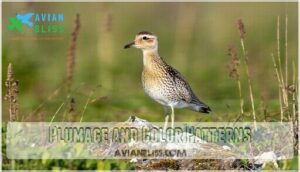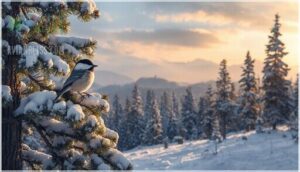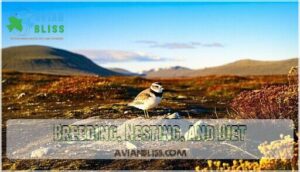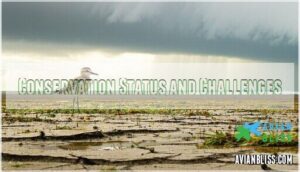This site is supported by our readers. We may earn a commission, at no cost to you, if you purchase through links.

You’ll find this 9-10 inch shorebird pulling off mind-blowing feats – flying over 26,000 kilometers annually between Arctic tundra and tropical Pacific shores.
Its golden-brown plumage with black and white markings makes it a standout, while those long legs and upright stance give it serious runway model vibes.
These birds nail 4,000-kilometer nonstop flights using internal compasses and star maps that’d make GPS jealous.
They’re creatures of habit too, returning to the same spots year after year like they’ve got permanent reservations.
The navigation secrets and survival strategies these remarkable birds use reveal fascinating adaptations you won’t believe.
Table Of Contents
- Key Takeaways
- Physical Characteristics and Identification
- Habitat and Distribution
- Migratory Journey and Behavior
- Breeding, Nesting, and Diet
- Conservation Status and Challenges
- Frequently Asked Questions (FAQs)
- What was the most amazing fact about the golden plover?
- What do Pacific Golden-Plovers eat?
- What do pacific golden plovers eat?
- How long do pacific golden plovers live?
- Are pacific golden plovers endangered?
- Do pacific golden plovers mate for life?
- Can pacific golden plovers be kept as pets?
- How long do Pacific Golden-Plovers live?
- What predators threaten Pacific Golden-Plover eggs?
- Do Pacific Golden-Plovers migrate in flocks?
- Conclusion
Key Takeaways
- You’ll witness one of nature’s most incredible endurance feats—these birds fly nonstop for over 4,000 kilometers across open ocean, covering up to 26,000 kilometers annually in their migration cycles.
- You can identify them by their distinctive golden-brown plumage with black and white markings, upright stance, and medium size (9-10 inches), plus they’re larger than killdeer but smaller than black-bellied plovers.
- You’ll find these remarkable navigators using internal magnetic compasses and celestial cues to travel between Arctic tundra breeding grounds and tropical Pacific wintering areas with pinpoint accuracy.
- You should know they’re currently listed as "Least Concern" but face mounting threats from habitat loss, climate change affecting their Arctic breeding grounds, and human disturbance along critical coastal stopover sites.
Physical Characteristics and Identification
You’ll recognize the Pacific Golden Plover by its medium build—larger than a robin but smaller than a crow, measuring 9-10 inches long with distinctive golden-brown, black, and white plumage.
Its upright posture, large head, slim neck, and long legs make it stand out from similar shorebirds like the Killdeer or Black-bellied Plover.
Size and Body Structure
You’ll recognize a Pacific Golden Plover by its robin-to-crow bird size, measuring 9.1-10.2 inches with distinctive body proportions.
This medium-sized shorebird displays an upright posture, large head shape, and slim neck. Its relatively long leg length and extended wing span create perfect balance for tundra navigation.
The bird’s compact frame weighs just 3.6-3.8 ounces, making it larger than killdeer but smaller than black-bellied plovers.
Understanding bird identification techniques is essential for distinguishing the Pacific Golden Plover from other similar species, using complete concepts and bird identification.
Plumage and Color Patterns
You’ll notice the pacific golden plover’s stunning golden-brown upperparts create perfect plumage camouflage against tundra vegetation.
Their golden plumage features intricate black markings that shift through distinct color morphs during molt cycles.
Pattern variations include white-speckled wing coverts and darker flight feathers.
The bird plumage patterns change seasonally, with breeding adults showing more vibrant colors, and the feather texture appears smooth and streamlined for long-distance flight.
The distinctive color pattern helps distinguish them from similar species.
Distinctive Features for Identification
You’ll spot Pacific Golden Plovers by their upright stance and proportionally large head on a slim neck.
Their distinctive beak shape appears straight and medium-length, perfect for probing tundra soils.
Notice the bright orange-yellow leg color that stands out against darker substrates.
Head markings include bold white stripes above and below the eye during breeding season.
These field marks make bird identification straightforward when observing plumage patterns and feather texture variations, using complete concepts to guide the process.
Comparison With Similar Species
You’ll find Pacific Golden-Plovers easiest to distinguish through careful bird species comparison with three similar shorebirds:
- American Golden-Plover – Shows darker underparts during breeding season and prefers inland grasslands over coastal areas
- Black-bellied Plover – Displays distinctive black "armpit" patches in flight and maintains bulkier build year-round
- Killdeer – Features prominent double breast bands and lacks the golden-brown plumage patterns typical of plover species
These shorebird analysis techniques help separate Pacific Golden-Plovers from look-alikes.
Habitat and Distribution
Pacific Golden Plovers span vast distances between their Arctic breeding grounds and Pacific wintering territories.
You’ll find these remarkable birds nesting across tundras from western Alaska to Russia’s Yamal Peninsula, then wintering from coastal California all the way to northeast Africa, which involves vast distances and remarkable migrations.
Breeding Grounds in The Arctic Tundra
Across the vast Arctic tundra, you’ll discover Pacific Golden Plovers establishing their breeding grounds from western Alaska to Russia’s Yamal Peninsula.
These migratory shorebirds claim expansive nesting territories spanning 10-50 hectares, with males displaying remarkable territorial behavior through aerial displays and distinctive vocalizations.
Their mating rituals unfold in this harsh yet pristine tundra habitat, where both partners fiercely defend their chosen nesting sites against intruders, showcasing their unique mating rituals and strong nesting territories.
Wintering Locations Across The Pacific
Pacific Golden Plovers you’ll see wintering across vast Pacific islands stretch their wings from coastal California to northeast Africa.
These migratory shorebirds show remarkable site fidelity, returning to identical stopover sites year after year.
Their wintering grounds include:
- Hawaiian beaches where locals spot them strutting confidently
- Australian coastlines offering rich feeding opportunities
- Southeast Asian shores providing essential oceanic stops
Each Pacific Golden Plover claims the same wintering areas annually, making these coastal habitats essential migration routes.
Understanding migrating bird habitats is vital for conservation efforts to protect these species.
Migratory Journey and Behavior
You’ll witness one of nature’s most incredible feats when you observe the Pacific Golden Plover’s migration—a journey that spans up to 10,000 kilometers between Arctic breeding grounds and tropical wintering areas.
These remarkable birds demonstrate extraordinary endurance by completing nonstop transoceanic flights exceeding 4,000 kilometers across open ocean without a single rest stop, showcasing their ability to undertake such an incredible journey.
Long-Distance Migration Patterns
You’ll witness one of nature’s most incredible journeys when tracking Pacific Golden Plovers across their migration routes.
These birds complete transoceanic flights spanning up to 10,000 kilometers between Arctic breeding grounds and tropical wintering areas.
Their flight patterns include nonstop stretches exceeding 4,000 kilometers over open ocean, pushing endurance limits beyond most species.
Satellite bird tracking reveals consistent migratory patterns with remarkable route loyalty year after year.
The Pacific Golden Plovers’ ability to navigate using migration patterns is a key factor in their successful long-distance migrations.
Navigational Skills and Endurance
You’ll witness nature’s most impressive navigation system when Pacific Golden-Plovers cross vast ocean expanses.
These birds use internal magnetic compasses and celestial cues to maintain precise flight paths during their incredible transoceanic journeys.
Their remarkable endurance capabilities include:
- Flying 4,000+ kilometers nonstop over open Pacific waters
- Maintaining steady wingbeats for 50+ hours without rest
- Using fat reserves that fuel their entire ocean crossing
- Reading wind patterns to optimize flight efficiency
- Following ancient migratory routes with pinpoint accuracy
The combination of these abilities allows Pacific Golden-Plovers to achieve incredible transoceanic journeys and maintain their species’ survival through precise flight paths.
Site Fidelity and Territory Reoccupation
You’ll discover that these remarkable birds demonstrate unwavering loyalty to specific locations.
Both breeding and wintering sites show consistent reoccupation patterns year after year. Males exhibit particularly strong site fidelity to breeding territories, while both sexes return to identical wintering grounds annually.
| Territory Aspect | Behavioral Pattern |
|---|---|
| Breeding Territory Size | 10-50 hectares per pair |
| Male Site Loyalty | Returns to same breeding area annually |
| Wintering Site Fidelity | Both sexes reoccupy identical locations |
| Territory Defense | Active protection against intruders |
| Habitat Selection | Consistent preferences across seasons |
Notable Research and Tracking Insights
Tracking technology has revolutionized our understanding of Pacific Golden Plover migration patterns.
GPS tags reveal individual birds fly over 26,000 kilometers annually, with some nonstop flights exceeding 8,000 kilometers across open ocean.
Research findings show Japan serves as vital stopover habitat, where migratory birds refuel for weeks.
These species monitoring breakthroughs inform conservation efforts protecting critical flyway corridors for shorebird populations.
The study of satellite tracking methods has substantially enhanced our knowledge of Pacific Golden Plover migration routes and behaviors.
Breeding, Nesting, and Diet
You’ll discover that Pacific Golden Plovers transform into devoted parents once they reach their Arctic breeding grounds, establishing territories through impressive aerial displays and calls.
Their simple ground nests become the foundation for raising the next generation of these remarkable long-distance migrants.
Mating and Territorial Displays
After completing their epic migrations, males establish territories through dramatic aerial flights and wing displays. You’ll observe complex courtship rituals where males perform elaborate vocalizations to attract females.
Territorial defense becomes intense as breeding season peaks, with pair bonding strengthening through synchronized behaviors. The plovers’ mating habits involve understanding their plover mating patterns to appreciate their unique courtship displays.
- Males defend territories ranging 10-50 hectares using aerial displays and calls
- Courtship displays include ground posturing, wing-spreading, and ritualized running patterns
- Vocalizations consist of melodic trills and sharp alarm calls for mate selection
- Both sexes participate in territorial defense against intruding plovers during breeding
Nest Construction and Egg Incubation
Pacific Golden-Plovers construct simple yet effective nests in shallow depressions across Arctic tundra.
You’ll find these plover nesting sites lined with available nest materials like lichens, grass, and twigs.
Both parents share egg laying duties, typically producing four spotted eggs.
The incubation period spans 26-27 days, with both sexes alternating bird egg incubation responsibilities to maintain ideal temperatures.
Conservation efforts often involve installing plover nesting boxes to protect and support these birds in their natural habitat, using effective methods and providing support.
Chick Development and Parental Care
Young chicks hatch with downy plumage and open eyes, ready to leave the nest within hours.
Both parents share feeding duties, guiding their precocial offspring to food sources across the tundra.
During this critical fledgling stage, adults fiercely defend their young from predators while teaching essential foraging skills.
Bird chick survival depends heavily on parental protection and guidance through those vulnerable early weeks.
Feeding Habits and Diet
Once chicks hatch, you’ll notice parents shift from protecting eggs to securing food sources for their growing family.
Pacific golden plovers employ diverse foraging strategies, using their keen eyesight to spot insects, beetles, and flies through systematic run-stop-scan-peck behaviors.
Their dietary needs include berries, mollusks, and crustaceans, with feeding behaviors adapting to local resources, which supports both breeding success and migration preparation.
The Pacific Golden Plover’s survival depends on understanding its migratory patterns to conserve the species effectively, highlighting the importance of conservation efforts.
Conservation Status and Challenges
While Pacific Golden Plovers currently maintain a stable population status, you’ll find these remarkable birds face mounting challenges that threaten their future.
From shrinking coastal habitats to climate-driven changes in their Arctic breeding grounds, conservation efforts require your understanding of the complex threats these long-distance migrants encounter, including the impact of climate-driven changes.
Current Population and IUCN Listing
Currently, the Pacific Golden Plover maintains a global population between 190,000-250,000 individuals.
The IUCN lists this species as Least Concern, though Population Trends show decline.
Despite stable conservation status, Threat Assessment reveals concerning patterns:
- Global Listings: IUCN designation remains secure with G5 status
- Population trend: Decreasing trajectory despite substantial numbers
- Species Survival: Regional declines exceed 60% in some wintering areas
Habitat Loss and Human Disturbance
Development pressures threaten Pacific Golden Plover survival through habitat loss and human disturbance.
Urban expansion destroys critical shorebird habitat along coastlines where these birds rest and feed. Coastal erosion accelerated by construction removes nesting areas.
Pollution effects contaminate food sources while land degradation fragments remaining wilderness. Human impact increases as recreational activities disturb roosting sites, forcing energy-depleted migrants to relocate repeatedly during vital recovery periods.
Human disturbance and recreational activities are significant factors that affect the survival of Pacific Golden Plover, as they force energy-depleted migrants to expend more energy.
Impacts of Climate Change
Climate change hits Pacific Golden Plovers hard through Arctic Melting and Temperature Shifts that scramble their breeding timing.
Sea Level Rise threatens wintering islands while Ecosystem Disruption alters food sources.
Climate Modeling shows habitat loss accelerating across migratory pathways, and you’ll see breeding ranges shrinking northward as tundra vegetation changes eliminate suitable nesting sites for this vulnerable species.
International Conservation Efforts
International cooperation drives pacific golden plover conservation through coordinated efforts spanning multiple countries.
You’ll find these birds protected under thorough strategies addressing their entire migration route.
Key conservation initiatives include:
- Global Cooperation – Multi-country partnerships coordinate habitat protection across breeding and wintering grounds
- Migration Safety – International flyway programs protect critical stopover sites during long-distance journeys
- Species Research – Collaborative tracking studies monitor population trends and migration patterns
- Conservation Policies – Joint agreements guarantee consistent protection standards across Pacific regions
Effective conservation relies on understanding bird conservation efforts to inform strategic decisions.
Frequently Asked Questions (FAQs)
What was the most amazing fact about the golden plover?
You’ll be amazed that Pacific Golden-Plovers fly nonstop for over 4,000 kilometers across the Pacific Ocean during migration—one of nature’s most incredible endurance feats without any rest stops.
What do Pacific Golden-Plovers eat?
You’ll discover these birds aren’t picky eaters – they feast on insects, worms, crustaceans, berries, and small marine creatures.
Their diet shifts seasonally, adapting to whatever’s available during migration and breeding.
What do pacific golden plovers eat?
You’ll find these birds are opportunistic feeders, munching on insects, worms, crustaceans, berries, and small fish. They’re basically feathered vacuum cleaners, adapting their diet to whatever’s available seasonally.
How long do pacific golden plovers live?
Like medieval knights protecting their territory, you’ll find these hardy birds live approximately 10-15 years in the wild.
Though some exceptional individuals reach 20 years through avoiding predators and surviving their epic oceanic migrations.
Are pacific golden plovers endangered?
No, you don’t need to worry about Pacific Golden-Plovers being endangered. They’re classified as "Least Concern" by conservation groups, meaning their populations remain stable despite facing some habitat challenges.
Do pacific golden plovers mate for life?
Unlike two peas in a pod, Pacific golden plovers don’t mate for life.
They’re seasonally monogamous, meaning you’ll find pairs bonding during each breeding season but typically choosing different partners the following year.
Can pacific golden plovers be kept as pets?
No, you can’t legally keep Pacific golden plovers as pets. They’re protected migratory birds under federal law, requiring specialized care that’s impossible in captivity. Wild birds belong free.
How long do Pacific Golden-Plovers live?
Remarkable shorebirds often defy expectations with their longevity.
You’ll find Pacific Golden-Plovers typically living 10-15 years in the wild, though some exceptional individuals reach 20+ years despite their grueling transoceanic migrations, which is a testament to their remarkable longevity.
What predators threaten Pacific Golden-Plover eggs?
You’ll face Arctic foxes hunting eggs on tundra breeding grounds.
Raptors and Arctic foxes target younger and smaller birds, while both parents vigilantly defend their precious buff-colored clutch against these persistent predators.
Do Pacific Golden-Plovers migrate in flocks?
While some shorebirds travel together, you’ll find Pacific Golden-Plovers typically migrate solo or in small groups.
They don’t form large flocks like geese, instead relying on individual navigation skills during their remarkable transoceanic journeys.
Conclusion
Remarkably, Pacific Golden Plovers can fly 4,000 kilometers without stopping—that’s like crossing the entire continental United States without a break.
You’ve learned how these remarkable birds master one of nature’s most challenging journeys, traversing vast Pacific distances with precision that rivals modern technology.
Understanding the Pacific Golden Plover’s incredible adaptations helps us appreciate the delicate balance these migration marvels maintain between survival and environmental pressures threatening their future, which is a true natural wonder.
- https://macaulaylibrary.org/photo/33409941
- https://doi.org/10.2173/bow.pagplo.02
- https://www.iucnredlist.org/species/22693735/155529922
- https://waders.org.au/studying-waders/banding-shorebirds/satellite-transmitters-and-geolocators/pacific-golden-plover-satellite-tracking/
- https://pubs.usgs.gov/publication/70209597













